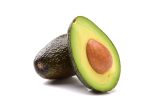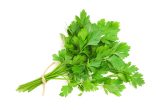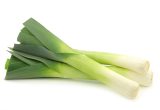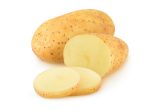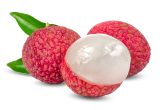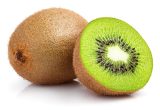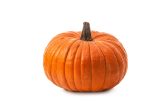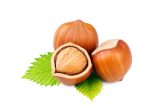Quince

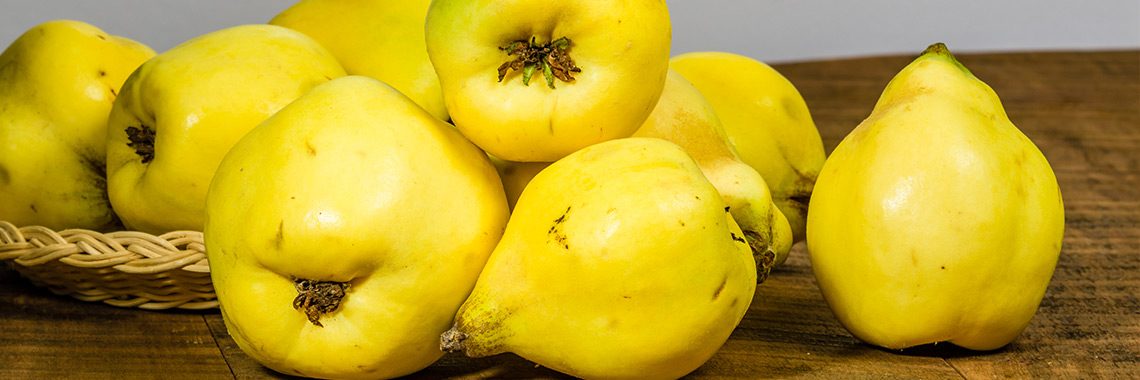
Description
- The quince tree (Cydonia oblonga) belongs to the Rosaceae family.
- It is native to warm temperate regions, including Asia Minor (Orhan, 2014).
- Turkey has the largest production of quince (22% of world production), followed by China, Uzbekistan, Morocco, Iran, Argentina and Azerbaijan (Orhan, 2014).
PHYSICAL AND ORGANOLEPTIC CHARACTERISTICS
- Quince is a small (5-8 m high and 4-6 m wide) deciduous tree (Orhan, 2014).
- Its fruit resembles apples and pears, bright yellow in colour when ripe (Orhan, 2014), hence the distinction of 2 subspecies:
- Cydonia oblongamaliformis, apple-shaped fruit;
- Cydonia oblongapyriformis, pear-shaped fruit (Yüksel, 2013).
- Polyphenol oxidase is the enzyme responsible for the browning of quince during ripening (Yildiz, 2020).
COMPOSITION CHARACTERISTICS (excluding macronutrients, vitamins and minerals)
- Quince contains notable amounts of phenolic compounds, such as flavonoids and phenolic acids, and secondary metabolites, such as procyanidins, shikimic acids and quinic acids (Sut, 2019). They give the fruit anti-carcinogenic, anti-allergic, antimicrobial, as well as antioxidant properties that are thought to limit oxidative stress associated with many pathologies (Sut, 2019; Hendrich, 2020).
- Bioactive compounds in quince, such as phenolic compounds and ascorbic acid, are reported to have anti-ulcer properties, reduce the risk of osteoporosis in women, lower blood glucose and blood cholesterol, and stabilise the nervous system (Yıkmış, 2019).
- The polyphenols contained in quince reportedly present antioxidant, anti-inflammatory and antibacterial capacities, in particular against E. coli (Hendrich, 2020).
- The main amino acids present in the fruit are aspartic acid, asparagine and glycine or hydroxyproline (Silva, 2004).
RAW
The following values are approximate and depend on variety, season, ripeness, cultivation conditions, etc. In the Ciqual table, energy values are calculated from the contents of lipids, protein, carbohydrates, dietary fibre, polyols, organic acids and ethanol, each with a specific energy value. Since quince is a food in which the presence of polyols and/or organic acids is suspected, and Ciqual does not have compositional data to quantify them, no energy value has been calculated (Ciqual 2020).
COMPOSITION TABLES
For each nutrient, the tables provide information on the content, minimum and maximum values, as well as the percentage of the Dietary Reference Value (DRVs) for 100 g net of whole raw quince (except for the table on polyphenols, which refers to peeled raw quince).
MACRONUTRIENTS
| Constituent (g) | Average content |
Min-Max per 100g |
DRV% |
|---|---|---|---|
| Water | 83,50 | - | - |
| Fibers | 1,90 | - | - |
| Carbohydrates | 13,40 | - | 5,15 |
| Sugars | 6,30 | - | 7 |
| Lipids | 0,10 | - | 0,14 |
| Saturated fat | 0,0085 | 0,007 - 0,01 | 0,04 |
| Protein | 0,51 | 0,40 - 0,63 | 1,02 |
| Constituent (g) | Amount | Min-Max | DRV% |
|---|---|---|---|
| Water | Ciqual 2020 | - | - |
| Fibers | Ciqual 2020 | - | - |
| Carbohydrates | Ciqual 2020 | - | Règlement (UE) N°1169/2011 du parlement Européen et du conseil du 25 octobre 2011 |
| Sugars | Ciqual 2020 | - | Règlement (UE) N°1169/2011 du parlement Européen et du conseil du 25 octobre 2011 |
| Lipids | Ciqual 2020 | - | Règlement (UE) N°1169/2011 du parlement Européen et du conseil du 25 octobre 2011 |
| Saturated fat | Ciqual 2020 | - | Règlement (UE) N°1169/2011 du parlement Européen et du conseil du 25 octobre 2011 |
| Protein | Ciqual 2020 | - | Règlement (UE) N°1169/2011 du parlement Européen et du conseil du 25 octobre 2011 |
Zoom on carbohydrates
- Quince contains a quantity of carbohydrates (13.40 g per 100 g) which is higher than the average content found in fresh fruit: about 11.31 g per 100 g.
Zoom on fibres
- The amount of fibre in quince (1.90 g per 100 g) is lower than the average content in fresh fruit (2.77 g per 100 g).
Zoom on proteins
- The protein content of quince (0.51 g per 100 g) is lower than the average amount in fresh fruit: 0.93 g per 100 g.
Zoom on lipids
- Its fat content (0.10 g per 100 g) is lower than the average amount in fresh fruit: 0.56 g per 100 g.
- Quince is fat-free* as it contains less than 0.5 g of fat per 100 g.
*Regulation (EC) No 1924/2006 of the European Parliament and of the Council of 20 December 2006 on nutrition and health claims made on foods.
MINERALS AND TRACE ELEMENTS
| Constituent | Average content |
Min-Max per 100g |
DRV% |
|---|---|---|---|
| Calcium (mg) | 11 | - | 1,38 |
| Chloride (mg) | - | - | - |
| Copper (mg) | 0,13 | - | 13 |
| Iron (mg) | 0,70 | - | 5 |
| Iodine (µg) | 0,40 | - | 0,27 |
| Magnesium (mg) | 8 | - | 2,13 |
| Manganese (mg) | - | - | - |
| Phosphorus (mg) | 17 | - | 2,43 |
| Potassium (mg) | 197 | - | 9,85 |
| Selenium (µg) | - | - | - |
| Sodium (mg) | 4 | - | - |
| Zinc (mg) | 0,04 | - | 0,40 |
| Constituent | Amount | Min-Max | DRV% |
|---|---|---|---|
| Calcium (mg) | Ciqual 2020 | - | Règlement (UE) N°1169/2011 du parlement Européen et du conseil du 25 octobre 2011 |
| Chloride (mg) | Ciqual 2020 | - | Règlement (UE) N°1169/2011 du parlement Européen et du conseil du 25 octobre 2011 |
| Copper (mg) | Ciqual 2020 | - | Règlement (UE) N°1169/2011 du parlement Européen et du conseil du 25 octobre 2011 |
| Iron (mg) | Ciqual 2020 | - | Règlement (UE) N°1169/2011 du parlement Européen et du conseil du 25 octobre 2011 |
| Iodine (µg) | Ciqual 2020 | - | Règlement (UE) N°1169/2011 du parlement Européen et du conseil du 25 octobre 2011 |
| Magnesium (mg) | Ciqual 2020 | - | Règlement (UE) N°1169/2011 du parlement Européen et du conseil du 25 octobre 2011 |
| Manganese (mg) | Ciqual 2020 | - | Règlement (UE) N°1169/2011 du parlement Européen et du conseil du 25 octobre 2011 |
| Phosphorus (mg) | Ciqual 2020 | - | Règlement (UE) N°1169/2011 du parlement Européen et du conseil du 25 octobre 2011 |
| Potassium (mg) | Ciqual 2020 | - | Règlement (UE) N°1169/2011 du parlement Européen et du conseil du 25 octobre 2011 |
| Selenium (µg) | Ciqual 2020 | - | Règlement (UE) N°1169/2011 du parlement Européen et du conseil du 25 octobre 2011 |
| Sodium (mg) | Ciqual 2020 | - | - |
| Zinc (mg) | Ciqual 2020 | - | Règlement (UE) N°1169/2011 du parlement Européen et du conseil du 25 octobre 2011 |
Zoom on minerals and trace elements
- Quince has a high copper and potassium content. It provides the equivalent of:
- 13% of DRVs for copper, i.e. 0.13 mg per 100 g; according to the Ciqual 2020 table, quince is one of the fruits with the highest copper content;
- 9.85% of DRVs for potassium, i.e. 197 mg per 100 g.
- The other minerals and trace elements are present in quantities representing less than 6% of DRVs.
VITAMINS
| Constituent | Average content |
Min-Max per 100g |
DRV% |
|---|---|---|---|
| Provitamin A Beta-carotene (µg) | - | - | - |
| Vitamin A equivalent (µg) | - | - | - |
| Vitamin B1 (mg) | 0,02 | - | 1,82 |
| Vitamin B2 (mg) | 0,03 | - | 2,14 |
| Vitamin B3 (mg) | 0,20 | - | 1,25 |
| Vitamin B5 (mg) | 0,081 | - | 1,35 |
| Vitamin B6 (mg) | 0,04 | - | 2,86 |
| Vitamin B9 (µg) | 3 | - | 1,50 |
| Vitamin C (mg) | 15 | - | 18,75 |
| Vitamin E (mg) | 0,55 | - | 4,58 |
| Vitamin K1 (µg) | - | - | - |
| Constituent | Amount | Min-Max | DRV% |
|---|---|---|---|
| Provitamin A Beta-carotene (µg) | Ciqual 2020 | - | - |
| Vitamin A equivalent (µg) | Calcul à partir de la valeur Provitamine A Béta-carotène* | - | Règlement (UE) N°1169/2011 du parlement Européen et du conseil du 25 octobre 2011 |
| Vitamin B1 (mg) | Ciqual 2020 | - | Règlement (UE) N°1169/2011 du parlement Européen et du conseil du 25 octobre 2011 |
| Vitamin B2 (mg) | Ciqual 2020 | - | Règlement (UE) N°1169/2011 du parlement Européen et du conseil du 25 octobre 2011 |
| Vitamin B3 (mg) | Ciqual 2020 | - | Règlement (UE) N°1169/2011 du parlement Européen et du conseil du 25 octobre 2011 |
| Vitamin B5 (mg) | Ciqual 2020 | - | Règlement (UE) N°1169/2011 du parlement Européen et du conseil du 25 octobre 2011 |
| Vitamin B6 (mg) | Ciqual 2020 | - | Règlement (UE) N°1169/2011 du parlement Européen et du conseil du 25 octobre 2011 |
| Vitamin B9 (µg) | Ciqual 2020 | - | Règlement (UE) N°1169/2011 du parlement Européen et du conseil du 25 octobre 2011 |
| Vitamin C (mg) | Ciqual 2020 | - | Règlement (UE) N°1169/2011 du parlement Européen et du conseil du 25 octobre 2011 |
| Vitamin E (mg) | Ciqual 2020 | - | Règlement (UE) N°1169/2011 du parlement Européen et du conseil du 25 octobre 2011 |
| Vitamin K1 (µg) | Ciqual 2020 | - | Règlement (UE) N°1169/2011 du parlement Européen et du conseil du 25 octobre 2011 |
Zoom on vitamins
- Quince is a source of vitamin C as it provides the equivalent of 18.75% of DRVs, i.e. 15 mg per 100 g.
- The other vitamins are present in quantities representing less than 5% of DRVs.
*Calculation made: Beta-carotene / 6+ retinol
POLYPHENOLS
Constituent
(mg)
Average content
Min-Max
per 100mg
Flavonoids
(mg)
5,84
5,42 - 6,53
of which
Flavonols
(mg)
0,59
0,17 - 1,28
of which
Flavanols
(mg)
5,25
5,25 - 5,25
Phenolic Acids
(mg)
13,39
0,71 - 29,95
of which
Hydroxycinnamic acids
(mg)
13,39
0,71 - 29,95
Total polyphenols
19,23
6,13 - 36,48
Constituent
(mg)
Amount
Min-Max
Flavonoids
Phenol Explorer, version 3.6 Méthode utilisée : Chromatographie
-
of which
Flavonols
Phenol Explorer, version 3.6 Méthode utilisée : Chromatographie
-
of which
Flavanols
Phenol Explorer, version 3.6 Méthode utilisée : Chromatographie
-
Phenolic Acids
Phenol Explorer, version 3.6 Méthode utilisée : Chromatographie
-
of which
Hydroxycinnamic acids
Phenol Explorer, version 3.6 Méthode utilisée : Chromatographie
-
Total polyphenols
Phenol Explorer, version 3.6 Méthode utilisée : Chromatographie
-
Zoom on polyphenols (per 100 g of peeled quince)
- Polyphenols are substances with an antioxidant effect.
- Quince contains mostly hydroxycinnamic acids (70%), a family of phenolic acids.
Nutrition and health claims
According to the definitions of nutrition claims as set out in Regulation (EC) No 1924/2006 on nutrition and health claims, and in view of the composition of raw quince, the following claims may be used:
NUTRITION CLAIMS OF RAW QUINCE
- Fat-free (100 g of quince contain less than 0.5 g of fat)
- Source of vitamin C (100 g of raw quince provide the equivalent of more than 15% of DRVs).
HEALTH CLAIMS (for a consumption of 100 g of raw quince)
Vitamin C
- Vitamin C contributes to:
- normal function of the immune system during and after intense physical exercise,
- normal collagen formation for the normal function of blood vessels,
- normal collagen formation for the normal function of bones,
- normal collagen formation for the normal function of cartilage,
- normal collagen formation for the normal function of gums,
- normal collagen formation for the normal function of skin,
- normal collagen formation for the normal function of teeth,
- normal energy-yielding metabolism,
- normal functioning of the nervous system,
- normal psychological function,
- normal function of the immune system,
- protection of cells from oxidative stress,
- reduction of tiredness and fatigue,
- regeneration of the reduced form of vitamin E.
- Vitamin C increases iron absorption.
References
-
Agence nationale de sécurité sanitaire de l’alimentation, de l’environnement et du travail. Table de composition nutritionnelle des aliments Ciqual 2020. Consultée le 20/08/2020 depuis le site internet Ciqual https://ciqual.anses.fr/
- Bystrická J, Musilová J, Lichtnerová H, Lenková M, Kovarovič J, Chalas M. The content of total polyphenols, ascorbic acid and antioxidant activity in selected varieties of quince (Cydonia oblonga Mill.). Potravinárstvo: Slovak Journal of Food Sciences. 2017;11(1): 77–81.
- Hendrich AB, Strugała P, Dudra A, Kucharska AZ, Sokół-Łętowska A, Wojnicz D, Cisowska A, Sroka Z, Gabrielska J. Microbiological, antioxidant and lipoxygenase-1 inhibitory activities of fruit extracts of chosen Rosaceae family species. Advances in Clinical and Experimental Medicine: Official Organ Wroclaw Medical University. 2020;29(2): 215–24.
- Orhan E, Nardemir G, Agar G, Ercisli S. Genetic variation among quince (Cydonia oblonga Mill.) genotypes sampled from the Coruh valley in Turkey. Genet Mol Res. 2014;13(1):445-9.
- Neveu V, Perez-Jiménez J, Vos F, Crespy V, du Chaffaut L, Mennen L, Knox C, Eisner R, Cruz J, Wishart D, Scalbert A. (2010) Phenol-Explorer: an online comprehensive database on polyphenol contents in foods. Database, doi: 10.1093/database/bap024. Full text (free access)
- Rasheed M, Hussain I, Rafiq S, Hayat I, Qayyum A, Ishaq S, Awan MS. Chemical composition and antioxidant activity of quince fruit pulp collected from different locations. International Journal of Food Properties. 2018;21(1): 2320–7.
- Règlement (CE) N° 1924/2006 du Parlement européen et du Conseil du 20 décembre 2006 concernant les allégations nutritionnelles et de santé portant sur les denrées alimentaires.
- Règlement (UE) N°432/2012 de la Commission du 16 mai 2012 établissant une liste des allégations de santé autorisées portant sur les denrées alimentaires, autres que celles faisant référence à la réduction du risque de maladie ainsi qu’au développement et à la santé infantiles.
- Règlement (UE) n°1169/2011 du Parlement européen et du Conseil du 25 octobre 2011 concernant l’information des consommateurs sur les denrées alimentaires, modifiant les règlements (CE) n°1924/2006 et (CE) n°1925/2006 du Parlement européen et de Conseil et abrogeant la directive 87/250/CEE de la Commission, la directive 90/496/CEE du Conseil, la directive 1999/10/CE de la Commission, la directive 200/13/CE du Parlement européen et du Conseil, les directives 2002/67/CE et 2008/5/CE de la Commission et le règlement (CE) n°608/2004 de la Commission.
- Taghinezhad E, Kaveh M, Jahanbakhshi A, Golpour I. Use of artificial intelligence for the estimation of effective moisture diffusivity, specific energy consumption, color and shrinkage in quince drying. Journal of Food Process Engineering. 2019;1: e13358.
- Silva BM, Casal S, Andrade PB, Seabra RM, Oliveira MB, Ferreira MA. Free amino acid composition of quince (Cydonia oblonga Miller) fruit (pulp and peel) and jam. J Agric Food Chem. 2004;52(5):1201-6.
- Sut S, Dall’Acqua S, Poloniato G, Maggi F, Malagoli M. Preliminary evaluation of quince (Cydonia oblonga Mill.) fruit as extraction source of antioxidant phytoconstituents for nutraceutical and functional food applications. Journal of the Science of Food and Agriculture. 2019;99(3):1046–54.
- Yildiz G, Izli G, Aadil RM. Comparison of chemical, physical, and ultrasound treatments on the shelf life of fresh-cut quince fruit (Cydonia oblonga Mill.). Journal of Food Processing and Preservation. 2020;44: e14366.
- Yıkmış S, Aksu H, Çöl BG, Alpaslan M. Thermosonication processing of quince (Cydonia Oblonga) juice: Effects on total phenolics, ascorbic acid, antioxidant capacity, color and sensory properties. Ciência e Agrotecnologia. 2019;43(3): e019919.
- Yüksel C, Mutaf F, Demirtaş İ, Öztürk G, Pektaş M, Ergül A. Characterization of Anatolian traditional quince cultivars, based on microsatellite markers. Genet Mol Res. 2013;12(4):5880-8.





